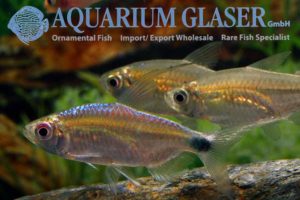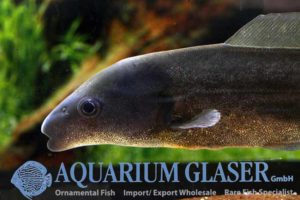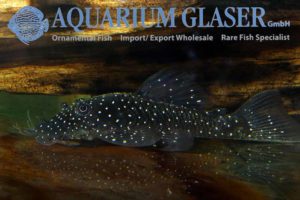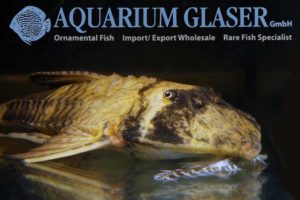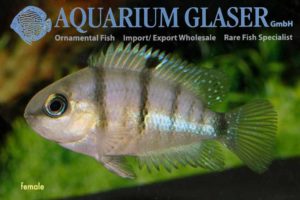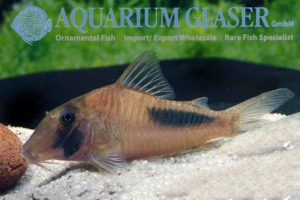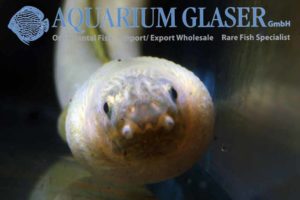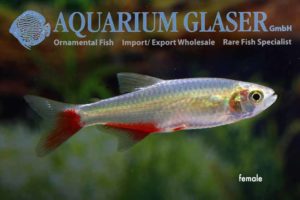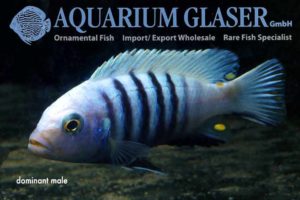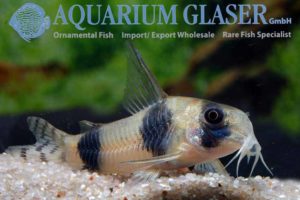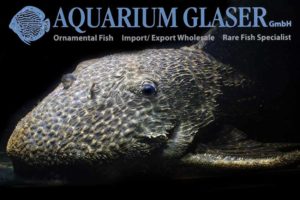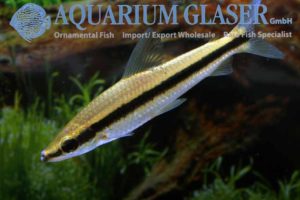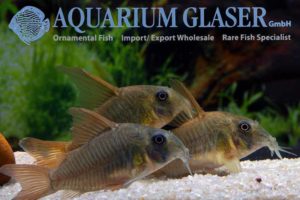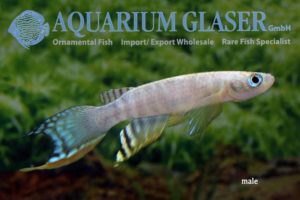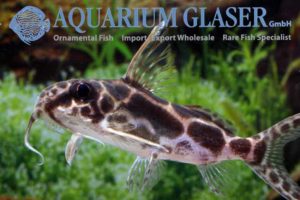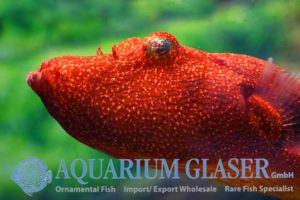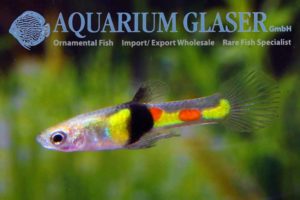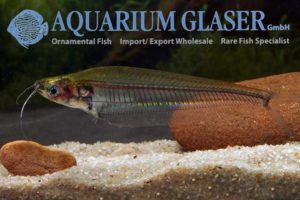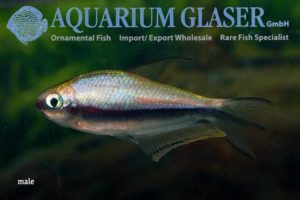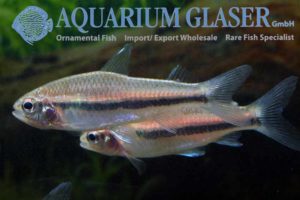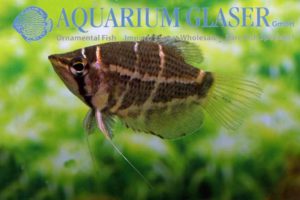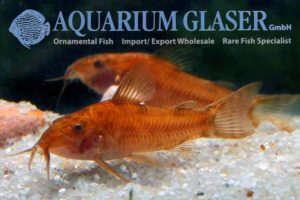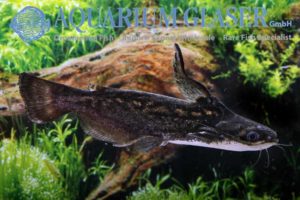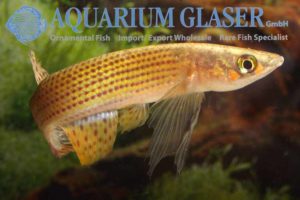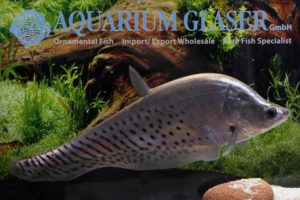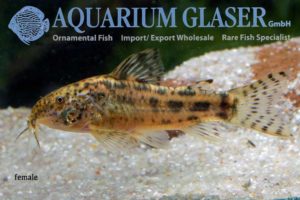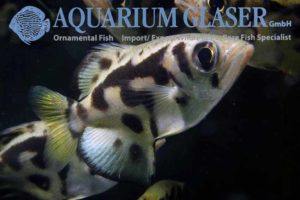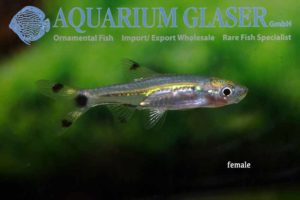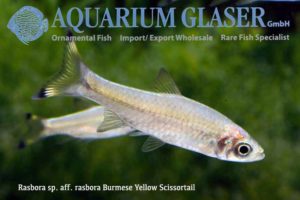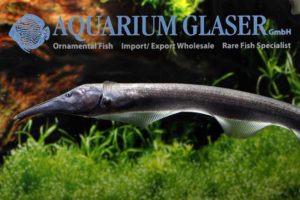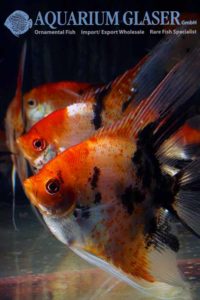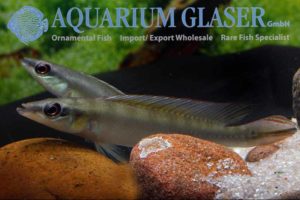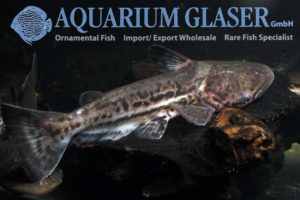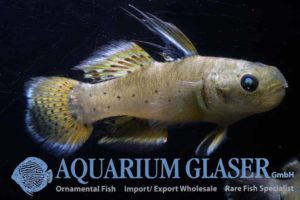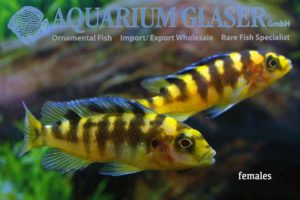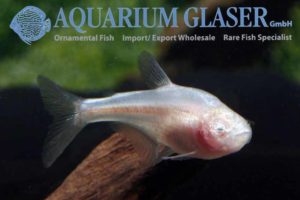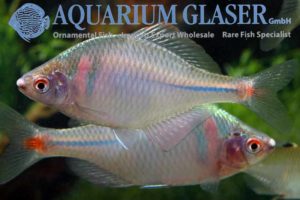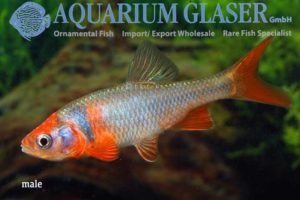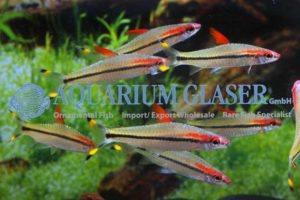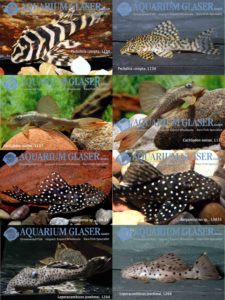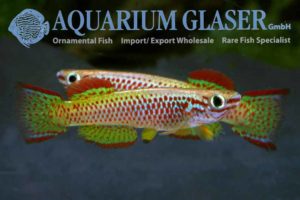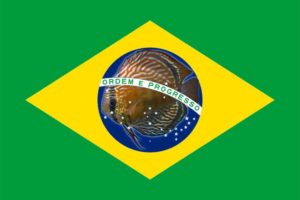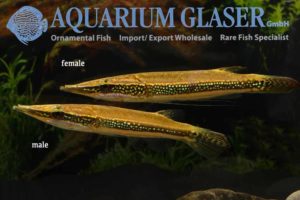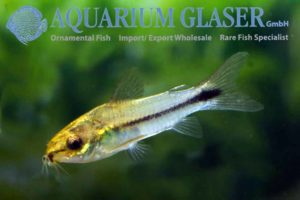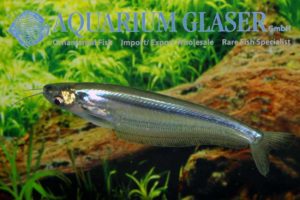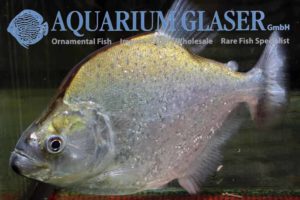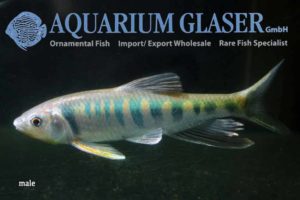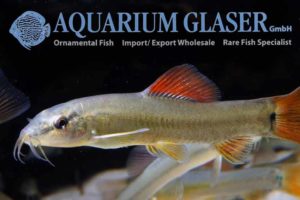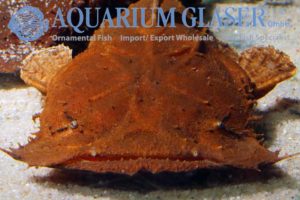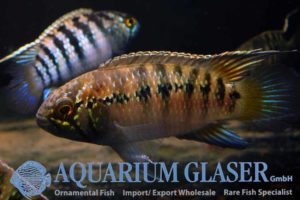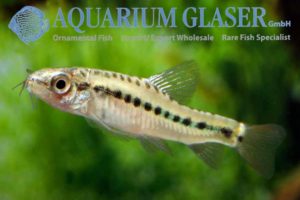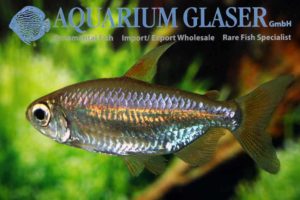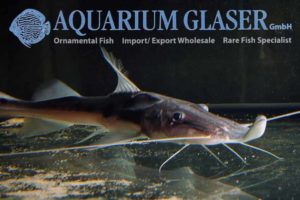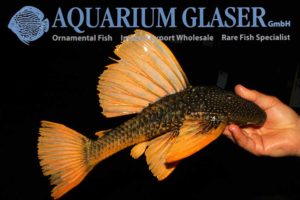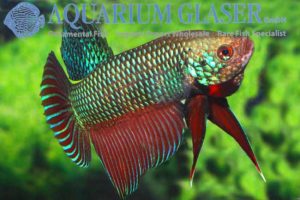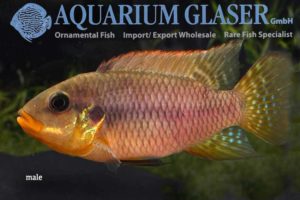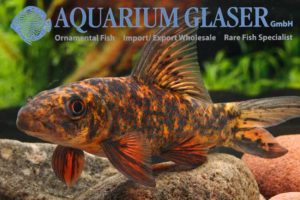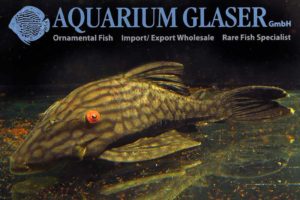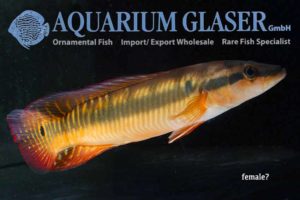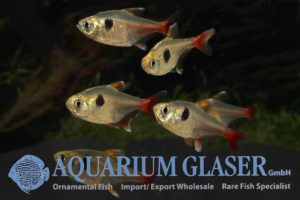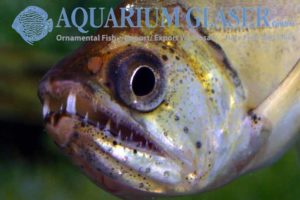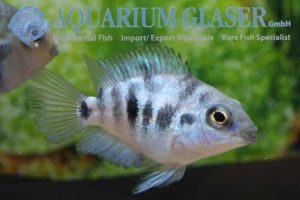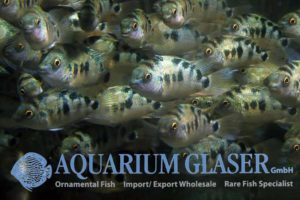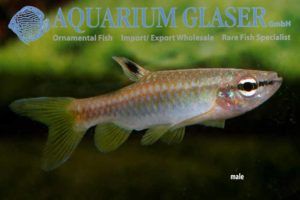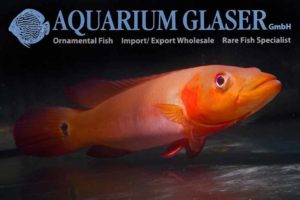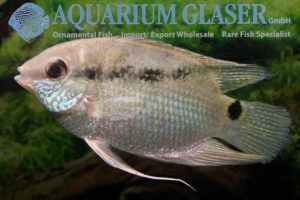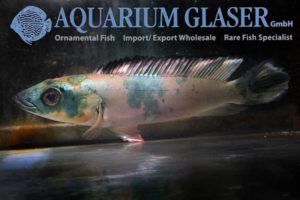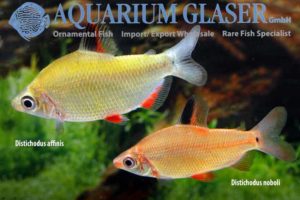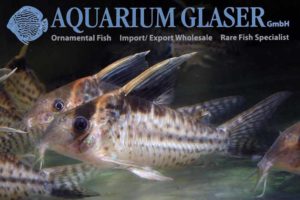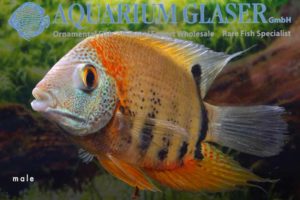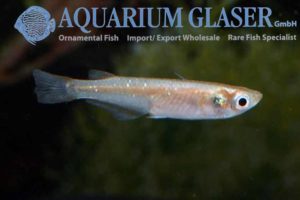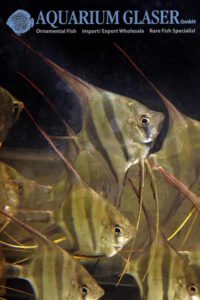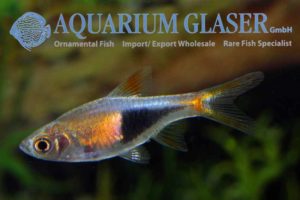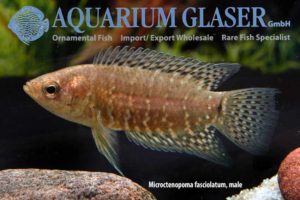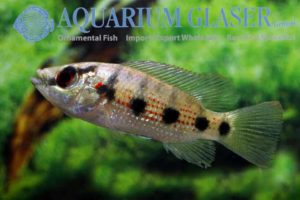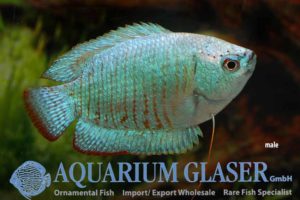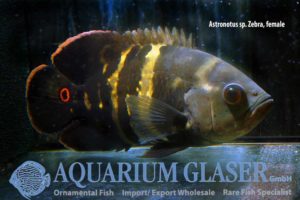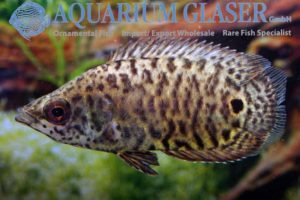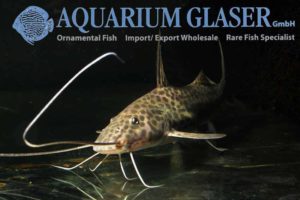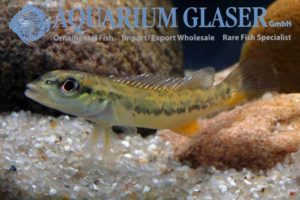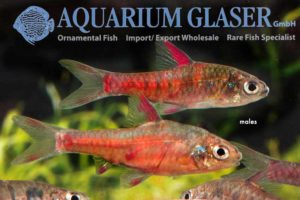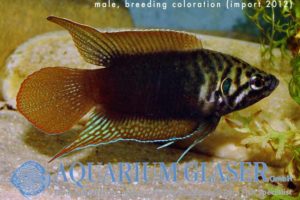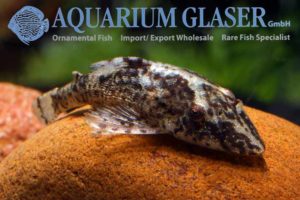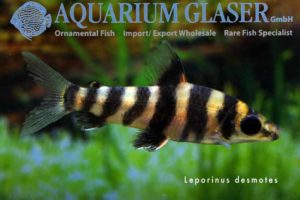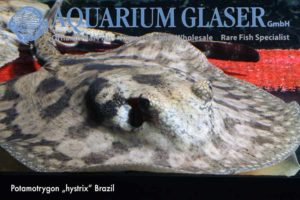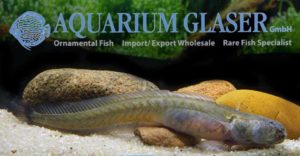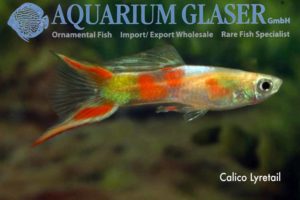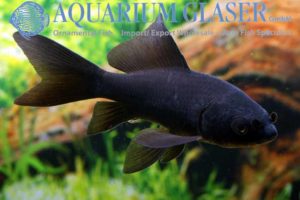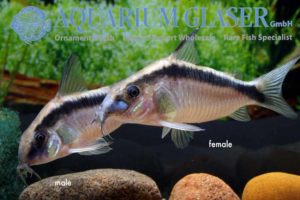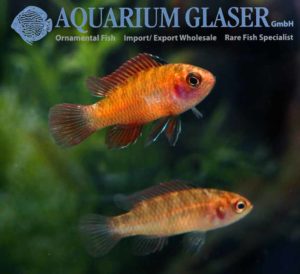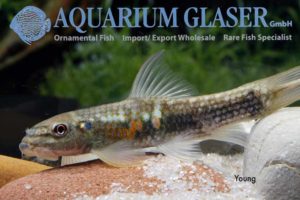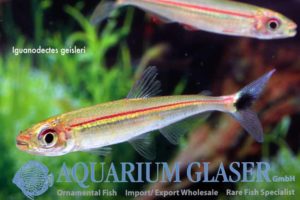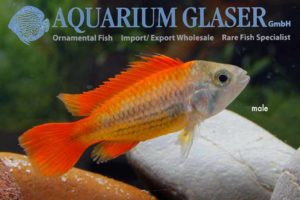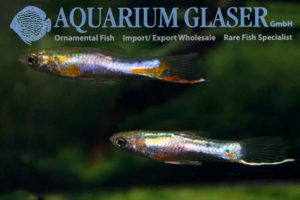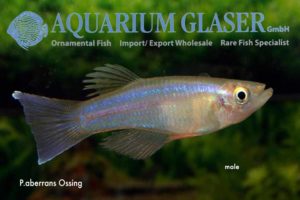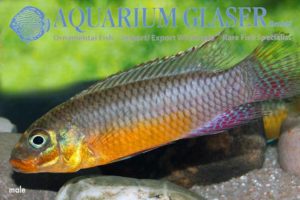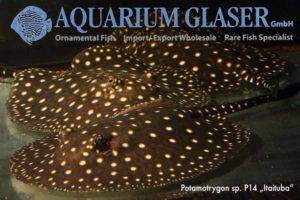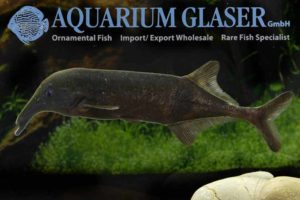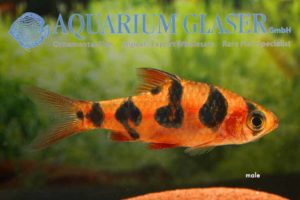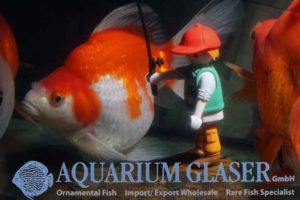Finally we were able to import once more one of the most beautiful African tetras: Alestopetersius smykalai. The species originates from Nigeria and becomes only 5-6 cm long. So it is a perfect fish also for owners of comparatively small tanks. Due to the wonderful blue back of the males – which differ from the […]
Fish Archive (2968)
-
-
Mormyrus rume
We received a species of bred fish from Singapore which is usually only traded as wild collected ones: Mormyrus rume. Currently the genus Mormyrus contains 24 species and subspecies. The determination is a very difficult task. Moreover, juveniles look totally different to adults. We obtained bred specimens of a species of Mormyrus from Singapore under […]
-
L107 / L184 Brillant-Ancistrus
Among the most beautiful species of Ancistrus is this one. It originates from the middle Rio Negro area in Brazil and is not yet determined scientifically. Instead even two L-numbers have been given to it, namely L107 and L184. The Brilliant Ancistrus is a very peaceful species. The number and size of the white spots […]
-
Paraloricaria vetula
The genus Paraloricaria contains three species that are distributed in southern South America. The fish are virtually unknown in the hobby. This is for sure at least in part due to the enormous size the fish can reach. At least P. commersonoides and P. vetula become larger than 50 cm. For the first time ever […]
-
Cryptoheros cutteri
We received very nice German bred specimens of this smaller cichlid from Honduras. Despite the comparatively small size – males obtain a maximum length of 13 cm, females always stay smaller – one should not keep these cichlids in small tanks. They have a very vivid temper, especially when they care for the offspring. The […]
-
Corydoras amapaensis
Finally we were able to import again a small number of the extremely rarely offered long snouted Corydoras amapaensis. The species is highly variable in respect of coloration. The sexes can be distinguished best by the shape of the spines of the pectoral fins, which are thickened and hairy in males. For our customers: the […]
-
Ophichthus apicalis
Eels (in the scientific sense) are usually no ornamental fish. But there is a greater number of species than one expects, and many of them are used for human consumption. We were able now to import a species of eel from Vietnam that was to the best of our knowledge never imported before alive: Ophichthus […]
-
Aphyocharax anisitsi wild
There are species of ornamental fish that are kept and bred already for such a long time that their conspecifics living in the wild are almost unknown now. Such a species is Aphyocharax anisitsi, the Bloodfin tetra. The first importation was back in 1906. The fish proofed to be easy to breed and very productive. […]
-
Cynotilapia pulpican
At the first glimpse Cynotilapia look very much alike the Malawi Zebras of the genus Maylandia In contrast to the zebras, in Cynotilapia the teeth are monoscupid (with two cusps in zebras). This difference is of more importance than one should think, for the zebras feed on Aufwuchs (eg the algae film on rocks etc. […]
-
Corydoras tukano
Hard to believe but true: it took five long years until we were able now to import once more Corydoras tukano. Now this pretty fish is finally available again. We obtained very stable, beautiful animals. For more information and how to distinguish C. tukano from its close relative C. reynoldsi, please see http://www.aquariumglaser.de/en/fish-archive/corydoras-en/_en-5/ For our […]
-
L234 Megalancistrus sp. Rio Urguayo
We were able to import two pretty gobbets from Paraguay, or, to be more detailed, from the Rio Urguayo. The two Megalancistrus are currently 40-50 cm long and show clearly why they have deserved their generic name: Megalancistrus means “gigantic Ancistrus”. Scientifically speaking, our fish most probably belong to the species M. parananus. For our […]
-
Laemolyta taeniata (= Anostomus taeniatus)
For many years we obtained the striped headstander that looks like the big brother of the golden pencilfish only in single specimens. Now we were finally able to import about 30 specimens of the pretty fish from Peru. The species is a typical headstander in all respects of behaviour. It can become larger than 20 […]
-
Corydoras concolor
We received really beautiful Corydoras concolor in a perfect size (md-lg) from Colombia. The sexually active males develop very pretty high fins. For our customers: the fish have code 226004 on our stocklist. Please note that we exclusively supply the wholesale trade. Text & photos: Frank Schäfer
-
Aphyolebias peruensis
Aphyolebias peruensis Once more we were able to import this beautiful killifsih from Peru. The pictures show animals from our current stock. For more informations, please see http://www.aquariumglaser.de/en/news/Aphyolebias_peruensis_en/ For our customers: the fish have code 342803 on our stocklist. Please note that we exclusively supply the wholesale trade. Text & photos: Frank Schäfer
-
Synodontis robertsi
The squeakers (Synodontis) are a very species-rich genus. More than 130 species are known, all of them originate from Africa. In the countries of their origin most species are used for food. In the aquarium hobby most species are unknown with a few exceptions. Among the most pretty, smallest and rarest species of Synodontis is […]
-
Tetraodon miurus
The Congo Puffer is one of the most remarkable species of freshwater pufferfish at all. The strictly solitary living species is a predator. It prefers to spend the day completely burrowed in sand. Only the mouth and the eyes peep out of the lair. If a potential prey comes along the puffer shoots out of […]
-
Endler´s Guppy El Tigre
One of our breeders in Thailand loves wild forms of small livebearers. He now was able to send us for the first time ever the “El Tigre” variety of Endler´s Guppy (Poecilia wingei). The fish represent a pure strain of a population that was initially collected in El Tigre, Venezuela. Of course the fish are […]
-
Kryptopterus minor
The “Ghost catfish” has been kept for more than 80 years under a wrong name in our tanks. Initially it was determined as Kryptopterus bicirrhis, afterwards as K. minor. However, both determinations proofed to be wrong, the species was in fact new to science and still undescribed! Now it has a final name, ie Kryptopterus […]
-
Nematobrycon palmeri wild
The emperor tetra (Nematobrycon palmeri) belongs for decades already to the most beloved species of tetra at all. This is due to its great beauty and interesting behaviour. The species is available the whole year through as bred ones. Wild collected ones, on the other hand, are available only seasonally. We recently obtained once more […]
-
Neolebias trewavasae
The genus Neolebias contains 12 species of small tetra from western Africa. Neolebias trewavasae attains a maximum length of about 5 cm and is one of the largest members of the genus. Sadly the species is only very rarely available in the trade, so we are glad that we could import them now once more […]
-
Sphaerichthys selatanensis
Sphaerichthys selatanensis The season for crossband chocolate gouramis has started. Finally the pretty small anabantoid is available again. For more information please see http://www.aquariumglaser.de/en/fish-archive/labyrinthfish-en/Sphaerichthys_selatanensis_en/ For our customers: the fish has code 455822 on our stocklist. Please note that we exclusively supply the wholesale trade. Text & photos: Frank Schäfer
-
Aspidoras sp. C125 Red
Yesterday we introduced to you the pretty Aspidoras taurus (see http://www.aquariumglaser.de/en/news/Aspidoras_taurus_en/). We received from the very same breeder for the first time the very nice albinotic red variety of Aspidoras sp. C125. The wild coloured variety looks quite similar to A. taurus, but the fish stays a bit smaller (4-4,5 cm). According to our breeder […]
-
Trachelyopterus fisheri
Currently we can offer a very odd species of catfish, namely Trachelyopterus fisheri. Initially this species of driftwood catfish orginates from Colombia where it is found in the system of the Rio Sucio. From that area only very occasionally importations appear. So we are quite happy that we have an adult wild collected male of […]
-
Moema hellneri (= M. cf. ortegai)
We were able to import astonishing large Moema hellneri (formerly: Moema cf. ortegai, see comment below) from Peru. The females are around 8 cm, the males around 12 cm long. This places them among the largest species of killifish known so far. The extremely large pectoral fins of the males are very impressive. However, the […]
-
Chitala blanci
The Asian featherbacks, which have a well developed dorsal fin, have been placed in the genus Notopterus for a long time. Nowadays the genus Notopterus is seen monotypic (it contains only the single species N. notopterus) and the high-backed forms have been placed in another genus, namely Chitala. Currently we have the very attractive species […]
-
Aspidoras taurus
This pretty species of catfish is found only very occasionally in the trade. The species is not allowed to be exported from Brazil currently, so exclusively bred specimens are traded. We just received a small number of the attractive species from one of our breeders. Aspidoras taurus reaches a maximum length of about 5-6 cm. […]
-
Toxotes blythii
This archer fish that lives exclusively in freshwater originates from Burma. It has been discovered as early as 1860 and received its correct scientific name in 1892. Since then it has not been found anymore. Only in 2004 the first specimens appeared in the international trade and were celebrated as a sensation. These first specimens […]
-
Rasbosoma spilocerca
This dwarf rasbora becomes only about 3 cm long. The species is new in our stocklist. The scientific description of the fish was under the name of Rasbora spilocerca, but nowadays it is placed in the monotypic (this means the genus contains only one species) genus Rasbosoma. The natural distribution of the charming fish is […]
-
Rasbora sp. Burmese Yellow Scissortail
We obtained for the first time ever a small number of a new species of Rasbora from Burma. The new fish is without any doubts a close relative of the Indian species Rasbora rasbora but differs in details of the tail fin pattern. Currently our fish are 3-4 cm long. For our customers: the fish […]
-
Sternrachorhynchus from Peru
This week we introduced to you already a species of knifefish from Peru: Brachyhypopomus brevirostris (see http://www.aquariumglaser.de/en/news.php#1122). The odd Sternarchorhynchus, which is theme of this newsletter, originates also from Peru, but belongs to a different family, eg the Apteronotidae. The number of described species of Sternarchorhynchus has risen enormously in the past few years. Up […]
-
Scalare Red Devil Show Size
We received 50 gorgeous, fully grown Red Devil Angels. The fish are German bred ones. Our opinion is: more colour is impossible! For our customers: the fish have code 697565 on our stocklist. Please note the we exclusively supply the wholesale trade. Text & photos: Frank Schäfer
-
Crenicichla regani Alenquer
The pike cichlids (Crenicichla) represent the most species-rich genus of cichlid at all. More than 130 species have been described. How many of them are valid is subject of discussions, but the number for sure increases to over 90. Some species become pretty large, more than 30 cm, but there are also real dwarf cichlids […]
-
Ageneiosus marmoratus
We were able to obtain this very rarely imported species of bottlenose catfish from Peru. A. marmoratus has a very wide distribution in Amazonia. The species is a predator that prefers to feed on live fish. The largest specimen known to science was about 20 cm long (ours are currently 12-15 cm long). It can […]
-
Stigmatogobius sadanundio
Most species of goby are ground dwelling fishes. Only few species have a free swimming behaviour. The knight goby is one of these rare exceptions. We can offer this pretty goby from India on a regular basis. Knight gobies live in estuaries and can live both in pure fresh and in pure marine water. However, […]
-
Pseudotropheus crabro
The colorful mouthbrooders from Lake Malawi – the so called mbuna – belong to the most popular aquarium fish over decades already. They are also called the “coralfish of freshwater”, for – like their salty relatives – they unite splendid colours and a rather quarrelsome temper. The latter is due to the very restricted food […]
-
Blind cave tetras
78 years ago a collector of ornamental fish – his name was C. Basil Jordan – discovered a blind species of tetra that lived in a cave in the state of San Louis Potosi in Mexico. Jordan was able to collect 100 specimens of the new fish and managed to bring them to the USA […]
-
Rhodeus ocellatus
When the talk is about bitterlings one initially thinks for the European Bitterling, Rhodeus amarus, which is currently banned in the UK. In fact, there are more than 70 species of these fascinating brood parasites that deposit their eggs in live freshwater mussels. We were able now to import a species of bitterling from Hongkong […]
-
Cyprinella lutrensis (=Notropis lutrensis)
Beautiful Cyprinella lutrensis in stock! There are many species of small cyprinids in North America, but only very few of them have made a career as ornamental fish. In contrast to the European minnows the Red Shiner (Cyprinella (formerly: Notropis) lutrensis) is a completely undemanding fish and does not need low water temperatures. The species […]
-
Phantastic wild collected Sahyadria denisionii from Karnataka!
The Red line shark (Sahyadria denisonii, formerly known as Barbus denosonii or Puntius densonii) is a very popular aquarium fish. Currently it is traded almost exclusively as bred specimens from Indonesia. For the first time ever we now received an import of S. denisonii from a new collection area in India. So far the species […]
-
L-numbers: the season starts for species from the Rio Tapajós!
-
Aphyosemion gabunense
We obtained beautiful German bred specimens of this really nice killifish. A. gabunense is the perfect species for all aquarists who like the colorful killifish group but did so far not dare to keep them: A. gabunense is a really hardy fish and pretty easy to keep. The Gabon killi attains a maximum length of […]
-
Semifinal! Brazil vs. Germany
vs. Is it possible to compare discus with guppys? Hardly! Both are wonderful fish, but completely different. A discus, more sailing than swimming through the tank, is fascinating to look at even for non-aquarists, but it is also almost impossible not be excited by the brilliant guppys. So one can say: whoever wins the semifinal […]
-
Luciocephalus aura
The pikeheads (Luciocephalus) are highly specialized labyrinth fish. They live as predators in blackwaters of Southeast Asia. Only two species are known, the “common” pikehead, which occurs on the Malay Peninsula and in Indonesia, and the Peppermint Pikehead, which is known so far only from the Province Jambi on Sumatra. Currently we are able to […]
-
Corydoras pygmaeus
The Dwarf corydoras (Corydoras pygmaeus) belongs without any doubts to the most attractive and interesting aquarium fish for small tanks. This dwarf becomes only 2-3 cm long and is a somewhat untypical member of its genus, for most species of Corydoras are bottom dwellers; C. pygmaeus prefers to swim in the open water column. Interestingly […]
-
Kryptopterus geminus
The glass catfishes of the genus Kryptopterus are close relatives of the Wels catfish (Silurus glanis). However, in contrast to this giant among the freshwater fishes (Wels catfish can attain a length of up to 2 meteres), the glass catfishes stay small. The largest species known so far (K. cheveyi from the Mekong basin) becomes […]
-
Serrasalmus geryi
Once more we were able to import a real top-rarity: Serrasalmlus geryi. This species of piranha is restricted to the basin of the Rio Tocantins in Brazil. According to scientific literature this species becomes around 20 cm long. Thus our specimens that measure between 16 and 22 cm are most probably fully gown already. This […]
-
Zacco platypus – large males arrived!
Currently we can offer large, 12-15 cm long males of this spectacular species of barb that reached us from Hongkong. Zacco are coldwater fish that can be kept either in unheated aquaria or in garden ponds. They love strong current! Smaller specimens (7-10 cm, both sexes) are also in stock. For our customers: the fish […]
-
Traccatichthys taeniatus
For the first time ever we could import this pretty, red-finned loach from Vietnam, which has the popular name “Peppermint Loach” due to the bright green shine on the flanks. The species attains a length of about 12 cm and is very peaceful. One should keep these fish always in groups, for they are very […]
-
Chaca bankanensis
The frogmouth catfishes of the genus Chaca are very unusual fish. Only four species are known. The look quite similar to each other and form a catfish family on their own, the Chacidae. Chaca lie on the bottom without any move for most of the day. They wait for shrimps or small fish that take […]
-
Ivanacara (= Nannacara) adoketa
Finally we could import again some wild collected specimens of this breathtaking beautiful dwarf cichlid. The fish are very lively and have very nice colours. All pictures were made in our fishhouse and show our current stock! Moreover we can offer German bred ones. For more informations on Ivanacara adoketa see http://www.aquariumglaser.de/en/fish-archive/dwarfcichlids-en/Nannacara_adoketa_en/ and http://www.aquariumglaser.de/en/fish-archive/dwarfcichlids-en/Nannacara_adoketa_2_en/ For […]
-
Yunnanilus brevis
Yunnanilus brevis is a species of loach that originates from Burma. Here it occurs only in Inle Lake. The species attains a length of only 4-5 cm and thus belongs to the small species of fish. In contrast to most other species of loach, this one is a free swimming, schooling species. The swimming behaviour […]
-
Alestopetersius cf. leopoldianus
Many species of African tetra have never been photographed alive or kept in aquaria. So it is often very difficult to determine a species of that group. We obtained for the first time ever from Lac Mai Ndombe (formerly known as Lake Leopold) a species of tetra that has wonderful shining colours in the right […]
-
Platystomatichthys sturio
Finally we are able again to offer one of the most bizarre species of predatory catfish of Amazonia: Platystomatichthys sturio. Anyone who sees the fish for the first time will think that the animal is distorted; however, the upturned snout-tip is rather species-specific. Nevertheless the grade of this upturn differs individually and depends also a […]
-
Hypostomus luteus
Yesterday the most beautiful of all plecos, Hypostomus luteus from Paraguay, arrived. Only fully grown specimens display the fantastic, reddish-yellow coloration, whereas young fish are black with light spots. All specimens are 35-40 cm long. For our customers: the animals have code 262639 and 262649 on our stocklist. Please note that we exclusively supply the […]
-
Betta smargdina wild
-
Benitochromis riomuniensis
We have some wild collected specimens of Benitochromis riomuniensis from Cameroon in stock. Benitochromis is closely related to the Pelvicachromis species and can be compared regarding the aquarium biology quite good with these peaceful and colorful cichlids. In contrast to Pelvicachromis, which are cave brooders, Benitochromis are biparental, ovophilous mouthbrooders. This means that both parents […]
-
Labeo variegatus
After a long time we were able once again to import this beautiful species of Labeo from the Congo. Scientifically speaking, the name “variegatus” is regarded only as a synonym of Labeo cyclorhynchus nowadays. However, it is pretty difficult to substitute a well known name – like Labeo variegatus – in the aquarium hobby by […]
-
L330 Panaque sp. Spotted 14-18 cm
We have some specimens of this gorgeous, wood-eating pleco in stock. L330 originates from Colombia. Fully grown specimens get a spotted pattern all over the body. Younger specimens can look quite similar to L190 or Panaque nigrolineatus, because they usually show a striped pattern. The yellow tips of the caudal fin are a good hint […]
-
Crenicichla zebrina
Does there exist anything like a dreamfish even in our days? Well, at least Crenicichla zebrina from Venezuela is a hot candidate! We were able to import two specimens of this top rarity which have a length of 15-20 cm. So far no external features are known for that species to separate males from females. […]
-
Megalamphodus roseus
The Yellow Phantom Tetra is one of the colorful, small species. The peaceful dwarfs – they become only around 3 cm long – have blood red caudal fins and a wonderful contrasting large black shoulder spot. The species originates from French Guyana, where it occurs in the rivers Maroni and Oyapock. There are no exports […]
-
Hydrolycus armatus
The complete opposite to the Yellow Phantom Tetra is the Giant Waterwolve. This fish-eating predator attains a maximum length of 75 cm and is thus the largest species of the four members of the genus Hydrolycus. Of course this animal is much sought after by owners of really big tanks and public aquaria; sadly larger […]
-
Amatitlania sp. Honduras Red Point
The Convict cichlid (Amatitlania nigrofasciatum, formerly Cichlasoma, Archocentrus or Cryptoheros nigrofasciatus) was for a long time one of the most popular species of cichlid in the aquarium. Nowadays it becomes rather rarely seen. Instead of that species another Amatitlania appreared some years ago on stage, named Amatitlania sp. “Honduras Red Point”. These fish seem not […]
-
Amatitlania sp. Honduras Red Point
Recently we could introduce to you this pretty dwarf cichlid that belongs to the closer relationship of the Convict cichlid (Amatitlania nigrofasciatum, formerly Cichlasoma n.), see http://www.aquariumglaser.de/en/news/Amatitlania_sp_Honduras_Red_Point_en/Now we obtained again specimens from our proved breeder. For our customers: the animals have code 674452 on our stocklist. Please note that we exclusively supply the wholesale trade. […]
-
Pyrrhulina australis
Finally we were able once more to import Pyrrhulina australis from Paraguay. The animals have pretty yellow caudal fins with a sky-blue seam, on the operculum is a shining, blue spot. The coloration of the body is changing with mood. Most often the fish display a dark horizontal band over the body, but this can […]
-
Crenicichla sp. Tapajós
At the beginning of this week we introduced to you the dwarf cichlid Teleocichla proselytus from the Rio Tapajós (see http://www.aquariumglaser.de/en/news.php#1040). A close relative, but much, much bigger is the gorgeous red Crenichichla sp. Tapajós that originates from the same river. The species is not described scientifically yet. Females (sadly too shy for a good […]
-
Mesonauta festivus
We received from Brazil very nice, wild collected flag cichlids. M. festivus is usually not kept due to its coloration, which is not very spectacular, but due to the interesting and peaceful behaviour. But the animals that reached us now have a very interesting, blue pattern in the face. The scales also show an attractive […]
-
Crenicichla lugubris Jutai
Once more we were able to import some specimens of this gorgeous large cichlid from the Jutai region. This time the shipment contained one male with an extraordinary marble pattern. For more informations please click http://www.aquariumglaser.de/en/news/Crenicichla_lugubris_Jutai_en/ For our customers: the fish have code 670746 on our stocklist. Please note that we exclusively supply the wholesale […]
-
Distichodus noboli and D. affinis
Finally we were able to organize again an import from the Congo. The shipment contained two very pretty species of Distichodus. They look quite similar on the first glimpse. Both species become about 15-20 cm long. For our customers: the fish have code 127002 (D. noboli) and 123002 (D. affinis) on our stocklist. Please note […]
-
Corydoras robustus
This cory belongs to the largest and most attractive species of Corydoras at all. They can reach a total length of 9-10 cm. Both sexes develop long, filamentous dorsal fins when fully grown. The males can be best recognized by the much longer ventral fins. For our customers: the fish have code 244106 on our […]
-
Heros cf. efasciatus Red Shoulder
We received wonderful wild collected specimens of this extraordinary species from Peru. Currently the fish are 9-12 cm long. Experts are still debating whether these fish belong to the species Heros efasciatus or to a scientifically still undescribed species of Heros. But all agree that they represent the most attractive Heros at all. Males can […]
-
Oryzias latipes
The Japanese Ricefish or Medaka is the typical pet of the Japanese scientists that work on genetics. Uncountable numbers of scientific papers exist about this fish. Nevertheless the wild type of Medaka is a top rarity in the ornamental fish trade. We now managed to obtain for the first time ever a wild type of […]
-
Altum angels: bred ones available!
We obtained very beautiful German bred Pterophyllum altum. The “Orinoco” strain is characterized by the very good shape of the body and a high degree of red in the fins. For our customers: the fish have code 698303 on our stocklist. Please note that we exclusively supply the wholesale trade. Text & photos: Frank Schäfer
-
Trigonostigma heteromorpha
Genetic investigations showed that there is not only one species of harlequin barb, but a number of sibling species, which have to be described scientifically yet. This becomes very obvious when we come across wild collected specimens. The depicted animal, for example, is a wildcaught from southern Thailand. It is much more elongate than the […]
-
Microctenopoma fasciolatum
Our current import from the D.R. Congo contains inter alia two pretty species of dwarf bushfish: Microctenopoma ansorgii and M. fasciolatum. While M. ansorgii, the Orange bushfish, is imported on a rather regular basis, M. fasciolatum is found only very rarely in the trade. The Striped bushfish – this is the common name of M. […]
-
Hemichromis elongatus
The Five Star General has a very wide distribution in western Africa and is one of the most beautiful species of cichlid at all. Sadly it is also one of the most aggressive species of cichlid and this is the reason why it is only very rarely seen in aquaria. The photographed specimens originate from […]
-
Colisa lalia Cobalt
Dwarf gouramis are the orchids among the freshwater aquarium fish. They are extremely beautiful, but also a bit of delicate, but if kept properly they are real eyecatchers. The Cobalt sport was developed only in the 1990ies and became very popular. Today the fish is among the most common species found in the ornamental fish […]
-
Large wild collected Zebra Oscars arrived!
The Oscar (Astronotus ocellatus) is by far the most popular species of large cichlid from South America. This is not only because it is so splendid coloured, but also due to its behaviour: the fish becomes much larger than 20 cm, but is of calm nature and can thus be kept and bred properly in […]
-
Ctenopoma acutirostre wild
The current import from the D. R. Congo also contained some wild collected leopard bushfish. This species is available as bred from Indonesia in the last years (see http://www.aquariumglaser.de/en/archiv.php?news_id=140), but wild collected ones are very rare in the trade. The animals show an extremely variable pattern, each individual has a different coloration. One of our […]
-
Aguarunichthys torosus
We could import a very special fish for the hobbyists specialized in predatory catfish from Peru: Aguarunichthys torosus. This species has been discovered only in 1986. Isn´t it fascinating that nature has the same solution for totally different species over and under the water? The spotted pattern of A. torosus is very similar to the […]
-
Teleocichla proselytus
We received this very rarely offered dwarf cichlid from the Rio Tapajós in Brazil. Like in the humphead cichlids of the genus Steatocranus in Africa, Teleocichla have a reduced swimming bladder; because of that they exclusively live near the bottom. Our specimens have very nice orange colours in the fins. For our customers: the fish […]
-
Barbus jae
Barbus jae is one of the smallest species of barb from Africa. It has been described from the river Dja in Cameroon. Sadly nowadays imports from Cameroon are very rare, so one has to be really lucky to find this jewel in a local pet shop. B. jae becomes only 2-3 cm long. Breeding B. […]
-
Macropodus ocellatus wild
Finally we were able to import again wild collected Chinese Paradise fish. The currently imported variety shows an interesting striped pattern in neutral mood. Males in breeding mood look wonderful and have very splendid colours. However, as our animals are not in breeding mood yet, we show here exceptionally a picture of a male that […]
-
Parotocinclus longirostris
These dwarf sucker cats reaches us from Brazil. They belong to the smallest species of sucker cat at all. Even fully grown they hardly extent 2.5 cm in length. The determination on species level is not absolutely confirmed, for obviously a complex of very similar species exists. However, in any case the fish are tiny […]
-
Leporinus desmotes
There are a number of ringed species of Leporinus. Each of them has its own special charme. We obtained a shipment of very nice, small Leporinus affinis from Peru. Currently they are about 5 cm long, but fully grown they will reach up to 30 cm length. A closer look on the fish made clear […]
-
Potamotrygon
Funny enough: some of the most popular species of a group in the trade are often totally unknown to science! This is for example the case in P. “hystrix” from the Rio Negro basin in Brazil. This species stays comparatively small – around 30 cm disc width – and is thus quite popular in the […]
-
Odontamblyopus rubicundus
This goby from the lower reaches of the river Ganges belongs clearly to the category “faces that can be loved only by a mother”. Despite the look the fish that can reach up to 25 cm in length are very interesting. One should be careful with possible tankmates. Any fish that fits the mouth will […]
-
Double Sword Guppys
What would the hobby be without guppys? Probably anyone who keeps ornamental fish has kept and bred at least once a guppy. The lively fish that shimmer in all colours of the rainbow are for sure among the most popular ornamental fish species at all. There are countless sports and even – genetically speaking – […]
-
Carassius auratus – Comet Black
We received this sport of the goldfish from China. The animals are suited not only for the garden pond (they are completely winterhardy), but look also very nice in lateral view. For our customers: the fish have code 808202 on our stocklist. Please note that we exclusively supply the wholesale trade. Text & photos: Frank […]
-
Corydoras sp Super Arcuatus
Finally we received again this gorgeous, rare species of Corydoras from the Rio Purus in Brazil. The fish become almost double size compared with the “common” Corydoras arcuatus. In any other respect both species can be handled the same: they are hardy and beautiful fish! For our customers: the animals have code 221855 on our […]
-
Dario hysginon (2)
The species of Dario – the Dwarf Badis – are in one respect comparable to their larger cousins of the genus Badis: they are Chameleon fish! Depending on mood or light the colours change a lot and fast. We have once more the Flame Red Dario, D. hysginon, from Burma in stock. The species becomes […]
-
Garra sp. Sunset-Goldscale
We received this new, impressive species of Garra from India. The most striking feature of the species is that they have large, shining scales on the flanks. The position and number of these scales differs individually. Depending on the light these scales shine bright blue, orange-red or golden. The fully grown males (the photographed specimen […]
-
Iguanodectes arrived!
We can offer currently three of the extremely attractive, only very occasionally imported species of Iguanodectes. from Venezuela arrived Iguanodectes geisleri (see http://www.aquariumglaser.de/en/fish-archive/tetras-en/south-america-en/Iguanodectes_geisleri_en/) and I. adujai, and from Brazil we obtained a species that porbably represents I. purusii. For our customers: the animals have code 264612 (I. geisleri), 264353 (I. adujai), and 264402 (I. cf. […]
-
Apistogramma cacatuoides Mega Orange
An orange sport of the cockatoo dwarf cichlid is already known for quite a long time. But now we received for the first time a new strain that has really wonderful orange coloration. The breeder calls it “Mega Orange” – and we agree! For our customers: the fish have code 617343 on our stocklist. Please […]
-
Poecilia wingei Blue Star
Poecilia wingei is also known as the Endler´s Guppy, named after the most common local variety of that species in the hobby. It stays much smaller than the common guppy and this daintiness makes the fish very attractive for many aquarists. As in the common guppy a lot of local varieties can be observed in […]
-
Procatopus aberrans and P. nototaenia
One of the beautiful species of Procatopus which we were able to import from Cameroon, has already been introduced to you: P. similis from Mundemba (http://www.aquariumglaser.de/en/news/Procatopus_similis_MUNDEMBA_en/). Now two additional species follow: Procatopus aberrans from Ossing and P. nototaenia from Yabassi. The latter is sometimes considered to be an undescribed species by killifish specialists and then […]
-
Pelvicachromis taeniatus Bipindi
Currently we can offer a great number of wild collected varieties of P. taeniatus from different localities in Cameroon. The local variety from Bipindi is characterized by a high degree of yellow colours, the females get a wonderful blue belly when displaying. For our customers: the fish have code 562702 on our stocklist. Please note […]
-
Beautiful P14/Itaituba, bred specimens
The taxonomy of the black river stingrays is very confusing. Three scientifically described species do exist: Potamotrygon henlei (described from the Rio Tocantins), P. leopoldi (described from the Rio Xingu), and P. garrapa (described from the Rio Branco). In P. henlei several varieties exist that possibly represent different, separate species. All specimens from the Rio […]
-
Campylomormyrus compressirostris
Currently only very occasionally importations from the DR Congo appear – mainly due to the unsatisfying flight situation. So it is highly appreciated that we finally were able to import some specimens of the bizarre genus Campylomormyrus that bear the common name elephant fishes. Systematics of Campylomormyrus are rather complicated; in all probability our fish […]
-
Desmopuntius rhomboocellatus
We obtained extremely beautiful, fully grown specimens of the Orange barb. We want to take the opportunity to bespeak one more of the numerous changes in genus names in small barbs from Asia. Desmopuntius – the name means “prisoner-barb” and refers to the striped pattern that is shown by all species included at least as […]
-
Our new employee Friedolin
Dear reader, we are glad to introduce to you our ew employee: Friedolin. Friedolin is a professional fisherman and originates from the house of Playmobil. Any time really large fish come into play, it is Friedolin´s part to face the truth. He is a real brave guy and helps you, dear reader, to realize how […]
- « Previous Page
- 1
- …
- 16
- 17
- 18
- 19
- 20
- …
- 30
- Next Page »





